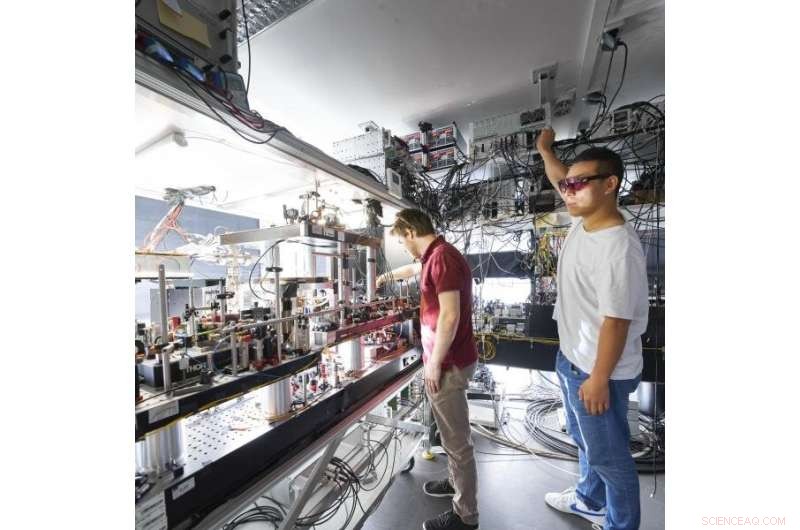
Esquema da configuração experimental. Em cada nó, localizado em prédios separados por 400 m, um único
87
O átomo Rb é carregado em uma armadilha óptica de dipolo. Ambos os átomos são excitados de forma síncrona para o estado 5
2
P3/2 |F′=0, mF′ =0⟩ para gerar o emaranhamento átomo-fóton no decaimento espontâneo subsequente. Os fótons únicos emitidos em um comprimento de onda de 780 nm são coletados usando objetivas de alta abertura numérica e acoplados em fibras monomodo que levam aos dispositivos QFC. Lá, eles são convertidos para comprimento de onda de telecomunicações (λ = 1,517 nm) por geração de frequência de diferença em um guia de onda de niobato de lítio (PPLN) com polarização periódica localizado em uma configuração do tipo interferômetro Sagnac, tal configuração mantém totalmente o estado quântico de polarização do fóton. Os fótons convertidos são guiados para uma estação intermediária por links de fibra com comprimentos de até 16,5 km, onde o emaranhamento é trocado para os átomos por um BSM. Depois de gerar com sucesso o emaranhamento átomo-átomo, os átomos são analisados independentemente por um pulso de leitura cuja polarização, definida por uma placa de meia onda (HWP) e uma placa de quarto de onda (QWP), define a configuração de medição. PC, controladores de polarização. Crédito:Natureza (2022). DOI:10.1038/s41586-022-04764-4
Uma rede na qual a transmissão de dados é perfeitamente segura contra hackers? Se os físicos conseguirem o que querem, isso se tornará realidade um dia com a ajuda do fenômeno da mecânica quântica conhecido como emaranhamento. Para partículas emaranhadas, a regra é:se você medir o estado de uma das partículas, saberá automaticamente o estado da outra. Não faz diferença a que distância as partículas emaranhadas estão umas das outras. Este é um estado de coisas ideal para a transmissão de informações a longas distâncias de uma forma que torna impossível a escuta.
Uma equipe liderada pelos físicos Prof. Harald Weinfurter da LMU e Prof. Christoph Becher da Universidade de Saarland já acoplou duas memórias quânticas atômicas em uma conexão de fibra óptica de 33 quilômetros de comprimento. Esta é a maior distância até agora que alguém já conseguiu emaranhar através de uma fibra de telecomunicações.
O emaranhamento da mecânica quântica é mediado por fótons emitidos pelas duas memórias quânticas. A decisive step was the researchers' shifting of the wavelength of the emitted light particles to a value that is used for conventional telecommunications. "By doing this, we were able to significantly reduce the loss of photons and create entangled quantum memories even over long distances of fiber optic cable," says Weinfurter.
Generally speaking, quantum networks consist of nodes of individual quantum memories—such as atoms, ions, or defects in crystal lattices. These nodes are able to receive, store, and transmit quantum states. Mediation between the nodes can be accomplished using light particles that are exchanged either over the air or in a targeted manner via fiber optic connection. For their experiment, the researchers use a system comprised of two optically trapped rubidium atoms in two laboratories on the LMU campus. The two locations are connected via a 700-meter-long fiber optic cable, which runs underneath Geschwister Scholl Square in front of the main building of the university. By adding extra fibers on coils, connections of up to 33 kilometers in length can be achieved.
A laser pulse excites the atoms, after which they spontaneously fall back into their ground state, each thereby emitting a photon. Due to the conservation of angular momentum, the spin of the atom is entangled with the polarization of its emitted photon. These light particles can then be used to create a quantum mechanical coupling of the two atoms. To do this, the scientists sent them through the fiber optic cable to a receiver station, where a joint measurement of the photons indicates an entanglement of the quantum memories.

Credit:Jan Greune
However, most quantum memories emit light with wavelengths in the visible or near-infrared range. "In fiber optics, these photons make it just a few kilometers before they are lost," explains Christoph Becher. For this reason, the physicist from Saarbrücken and his team optimized the wavelength of the photons for their journey in the cable. Using two quantum frequency converters, they increased the original wavelength from 780 nanometers to a wavelength of 1,517 nanometers.
"This is close to the so-called telecom wavelength of around 1,550 nanometers," says Becher. The telecom band is the frequency range in which the transmission of light in fiber optics has the lowest losses. Becher's team accomplished the conversion with an unprecedented efficiency of 57%. At the same time, they managed to preserve the quality of the information stored in the photons to a high degree, which is a condition of quantum coupling.
"The significance of our experiment is that we actually entangle two stationary particles—that is to say, atoms that function as quantum memories," says Tim van Leent, lead author of the paper published in
Nature . "This is much more difficult than entangling photons, but it opens up many more application possibilities."
The researchers think that the system they developed could be used to construct large-scale quantum networks and for the implementation of secure quantum communication protocols. "The experiment is an important step on the path to the quantum internet based on existing fiber optic infrastructure," says Harald Weinfurter.
+ Explorar mais On the way to quantum networks

